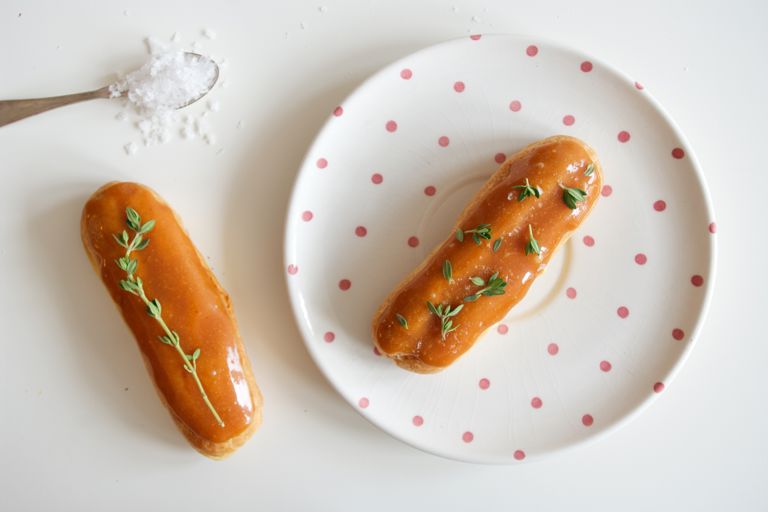Salted caramel and lemon thyme éclairs
This éclair is packed with luxurious, homemade salted caramel – both in the smooth, golden pastry cream and the thick layer of glaze. Although rich, the pastry cream is light and silky, and the caramel is balanced by the herbal, bright notes in the thyme.
Salted caramel remains a popular choice for desserts – the sweet, slightly bitter notes combining beautifully with flavour bursts of flaky sea salt. Here the caramelised sugar is used to flavour both the silky pastry cream and the rich, thick glaze.
A sprinkle of fresh, bright lemon thyme adds a little herbal contrast, and the flaky sea salt used to decorate the top brings bursts of crunchy texture and saline flavour.
Although I chose not to include them this time, strawberries make a great addition to this dessert and help to balance the caramel if you don’t like things too sweet. Trim and slice them into 4mm pieces and press into the pastry cream before adding the glazed top (pipe in a little less pastry cream to leave room for the berries) or arrange the slices on the lid for decoration. Or just serve on the side.
This recipe calls for a batch of six choux éclair shells. Please see the accompanying choux pastry recipe for éclairs for full instructions on how to make the dough.
The pastry cream needs to be made at least four hours ahead (even better overnight) of when you want to eat the éclairs, so bear this in mind when planning how you make the recipe.
You might have more salted caramel than you need for this recipe, as I have allowed for factors such as residue left on the pan. But there are plenty of uses for leftovers! It will keep for at least two weeks in the fridge – just bring to room temperature or warm slightly to soften before use.
Ingredients
Metric
Imperial
Salted caramel
- 100g of sugar
- 50g of butter
- 70g of double cream
- flaky sea salt to taste
Salted caramel pastry cream
- 110ml of whole milk
- 60ml of double cream
- 50g of sugar, or 4 tbsp
- 3 large egg yolks
- 16g of cornflour, or 2 tbsp
- 30g of butter
- 1 1/2 tsp vanilla extract, natural and preferably homemade
Salted caramel glaze
- 30g of icing sugar
To serve
- 6 sprigs of lemon thyme, to decorate
- flaky sea salt, to decorate
Method
Get in touch
Please sign in or register to send a comment to Great British Chefs.



